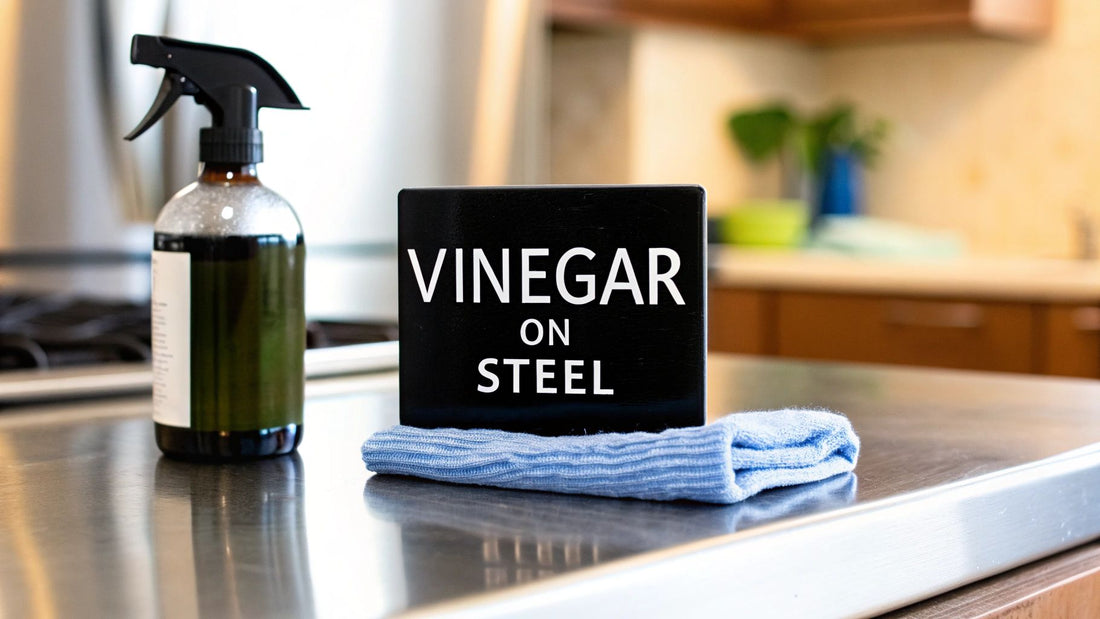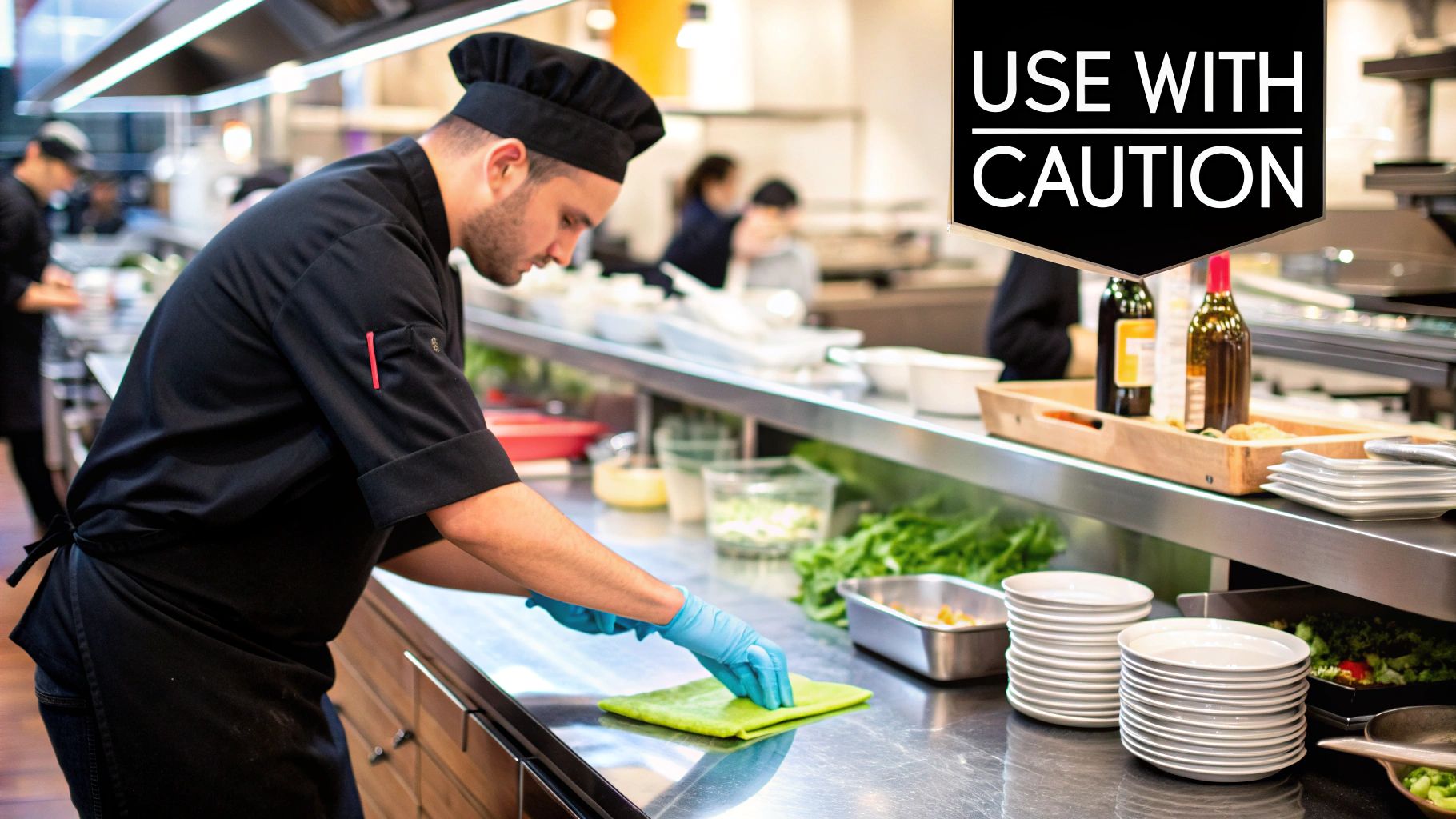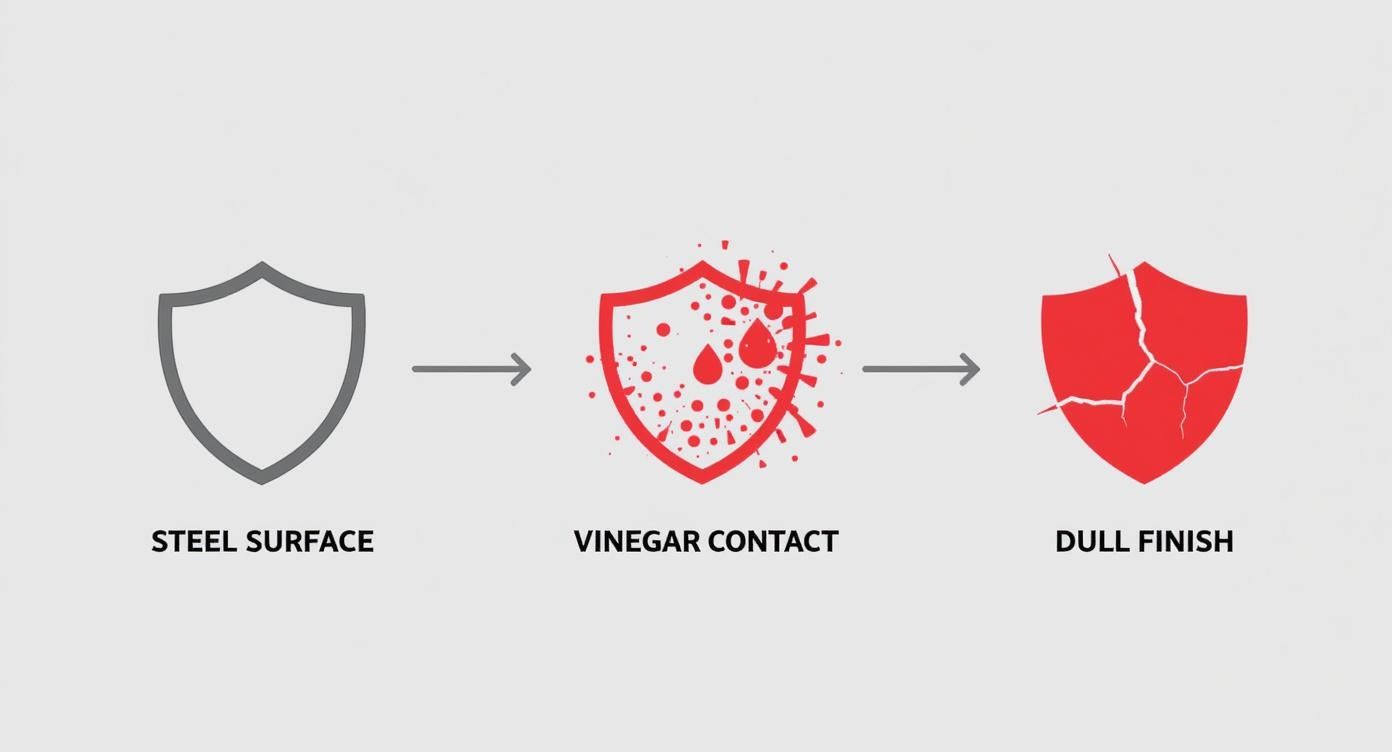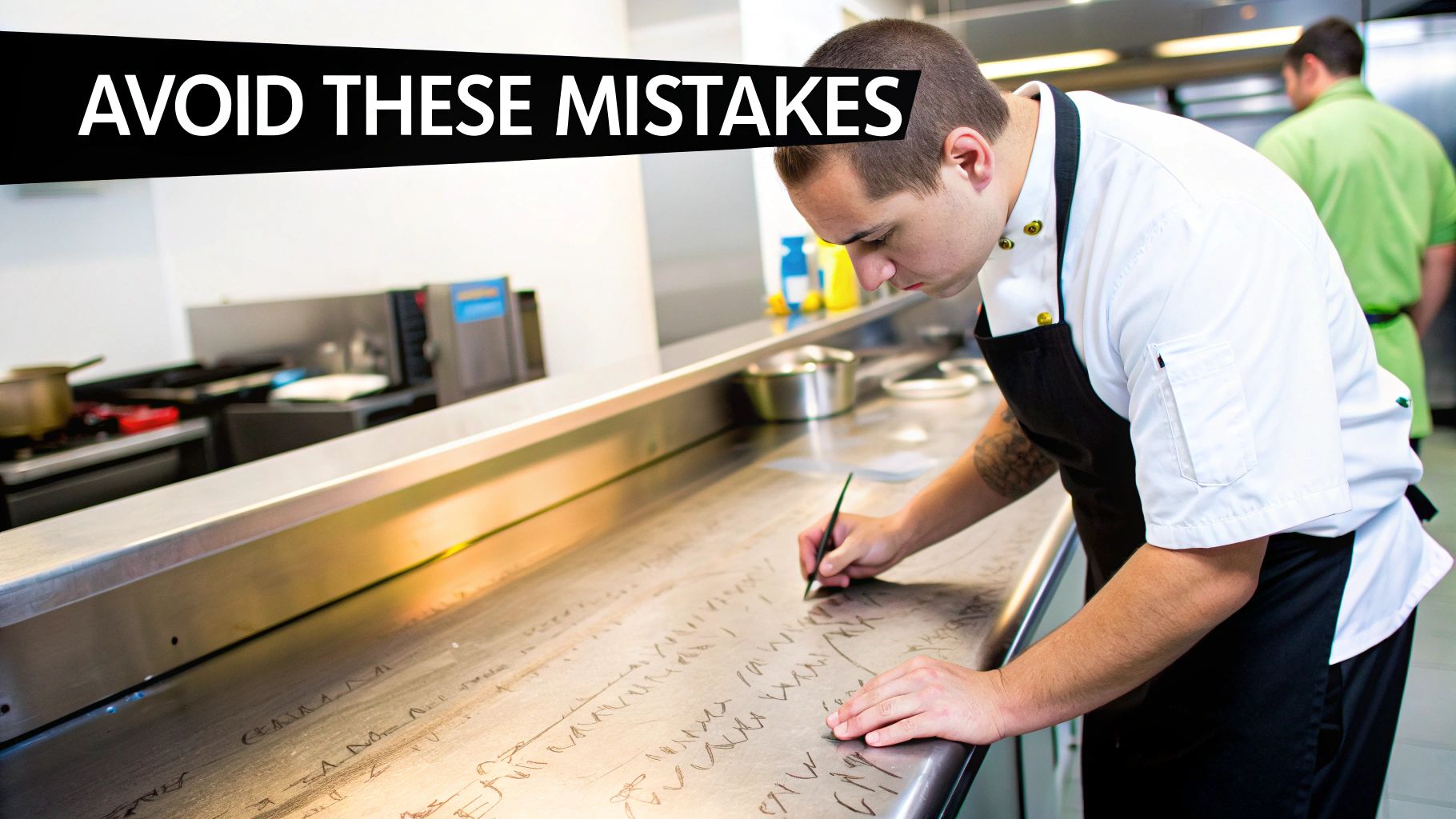
Can You Use Vinegar on Stainless Steel? A Guide for Restaurant Professionals
Share
So, can you use vinegar on stainless steel? The short answer is yes, but with a big asterisk. Think of it as a special-purpose tool in your cleaning arsenal, not your everyday go-to for wiping down every stainless steel surface in your kitchen.
The Quick Answer for Your Commercial Kitchen
In a high-paced restaurant environment, you can't afford guesswork that could damage expensive equipment. While vinegar is fantastic for certain jobs, grabbing it for daily cleaning can eventually dull the finish or, worse, compromise the protective layer of your stainless steel.
It’s a powerful problem-solver for specific issues, not a general-purpose cleaner.

Weighing the Risks and Rewards
The secret to vinegar's effectiveness lies in its mild acidity. The acetic acid is brilliant at breaking down things like mineral deposits from hard water or even light rust stains. As experts on cleaning with acids explain, this reaction can dissolve iron oxide without you having to scrub away and scratch the metal.
But that same acidity is exactly why you shouldn't use it all the time.
For routine cleaning, stick with neutral or alkaline products. They're formulated to cut through the grease and grime common in a kitchen without harming the metal's passive layer. See vinegar as a specialist, not an all-rounder.
To make sure your team gets it right every time, here’s a quick-glance guide on when vinegar is the right choice and when you should grab something else.
Vinegar on Stainless Steel: When to Use vs. When to Avoid
This table is a simple reference for your staff to quickly decide if vinegar is the right tool for the job.
| Situation | Use Vinegar? | Reason |
|---|---|---|
| Daily Wipe-Downs | Avoid | Can dull the finish over time and isn't a great degreaser. |
| Hard Water Spots | Yes | Its acidity is perfect for dissolving mineral deposits. |
| Faint Rust Stains | Yes | Dissolves rust (iron oxide) without harsh, damaging scrubbing. |
| Heavy Grease Buildup | Avoid | Alkaline-based cleaners are much more effective for cutting grease. |
A little training on this can go a long way in keeping your stainless steel looking pristine for years.
What Vinegar Actually Does to Your Stainless Steel
To get why vinegar is a "use with caution" cleaner for stainless steel, you have to know what makes the metal so tough in the first place. That gleaming surface on your prep tables and refrigerators isn't just plain steel. It's a smart alloy that includes at least 10.5% chromium, and that chromium is the secret to its incredible resistance to rust and corrosion.
When chromium meets oxygen in the air, it forms a super-thin, invisible shield called chromium oxide. This "passive film" is like a self-repairing coat of armor. It’s what stands between the iron in the steel and the water, food spills, and humidity that would otherwise cause a rust disaster in a busy kitchen.
Even better, this protective layer is self-healing. If you get a minor scratch on the surface, the newly exposed chromium immediately reacts with oxygen to patch the hole. It's a brilliant bit of chemistry and the reason stainless steel is the king of commercial kitchens.
How Acid Undermines Your Equipment's Defenses
So, where does vinegar fit in? The active ingredient, acetic acid, is the problem. While it's a weak acid compared to harsh industrial chemicals, it's still potent enough to start breaking down that vital chromium oxide layer.
Every time you clean with straight, undiluted vinegar, you're essentially launching a low-grade chemical assault on your equipment's built-in protection.
Think of it like the clear coat on your car. A single wash is fine. But scrubbing it with a harsh solvent every single day? You're going to strip away that protective layer and leave the paint underneath exposed to the elements.
Over time, this repeated chemical attack will start to show, and the results are not what you want to see on your pricey investments.
- Dulling the Finish: The first sign of trouble is usually a loss of shine. The acid microscopically etches the surface, making it look cloudy and flat instead of bright and reflective.
- Weird Discoloration: You might start to notice a strange rainbow-like sheen or even a brownish tarnish on the surface from prolonged exposure. This is a classic sign of acid damage.
- Pitting and Corrosion: This is the worst-case scenario. The acid finally wears through the protective film in small spots, allowing rust to get a foothold. You'll see tiny pits form, which are not only ugly but can also become breeding grounds for bacteria.
Knowing this science is key to cleaning smart. It's why vinegar can be a great tool for a specific, tough job, but also why it should never, ever be your daily, go-to cleaner for all your stainless steel.
The Right Way to Clean Stainless Steel with Vinegar
In a busy commercial kitchen, sometimes you run into a cleaning challenge that your usual go-to products can't handle. Think stubborn hard water spots on the dishtable or a little scale buildup in a sink. This is where vinegar can be a lifesaver—but only if you know how to use it without damaging your expensive equipment.
The key is dilution. Your best bet is a simple 50/50 mixture of plain white vinegar and water. Keep it in a clearly labeled spray bottle. Never, ever use straight, undiluted vinegar; it's just too acidic and dramatically increases the risk of etching the surface over time. This diluted mix is strong enough to cut through mineral deposits but gentle enough to keep the steel’s protective layer safe.
The Safe Application Method
Once your solution is ready, the process itself is simple, but the details matter.
Lightly mist the area you want to clean. You're aiming for a damp surface, not a soaking wet one. Drenching your equipment is a bad idea, as the excess liquid can easily find its way into seams or, worse, electrical components.
Grab a clean microfiber cloth and wipe, always following the direction of the metal’s grain. You can usually see the faint lines in the steel. Wiping against the grain is a classic mistake that leaves tiny scratches and dulls that professional, reflective finish.
This infographic really shows what's at stake—improper or prolonged vinegar use can eat away at the passive layer of stainless steel, leading to a dull, damaged finish.

It’s a great visual reminder of why you need to dilute the vinegar and minimize how long it sits on the surface. The acid needs to work, but it shouldn't be left to linger.
The final steps are absolutely crucial for a perfect, streak-free result. After wiping with the vinegar solution, immediately rinse the area with a separate cloth dampened with fresh, clean water. Then, with a third, completely dry microfiber cloth, buff the surface until it's totally dry. This prevents those annoying water spots from forming.
Boosting Cleaning Power Safely
What about really stubborn, greasy messes? This is where baking soda comes in. A fantastic trick is to sprinkle a light dusting of baking soda directly onto the gunk before spraying it with your vinegar solution.
You’ll get a satisfying fizzing reaction. That bubbling action helps lift caked-on grease and food residue, while the baking soda acts as a super-mild abrasive to scrub away the grime without scratching the steel.
Getting the balance right is important. For general tips, you can explore the perfect baking soda to vinegar ratio for cleaning. And if you're tackling larger appliances, our specific guide on how to clean the stainless steel refrigerator door has more detailed advice.
Costly Cleaning Mistakes Your Staff Should Avoid
When you’re running a busy kitchen, it’s easy to reach for a do-it-all cleaner like vinegar. But using it the wrong way can turn a simple cleanup into a costly repair, damaging the very equipment you rely on. Training your team on what not to do is just as critical as teaching them the right methods. It's about protecting your staff and your investment.

The biggest mistake we see? Letting vinegar—even when diluted—sit on the steel for too long. Sure, acetic acid is great at breaking down grime, but give it too much time, and it starts eating away at the protective layer of your stainless steel. This leads to that dreaded dull, cloudy look that makes new equipment look old. The rule in any professional kitchen should be simple: apply, wipe, rinse, and dry. Never let it sit for more than a couple of minutes.
Critical Safety and Equipment Don'ts
Beyond just how long you leave it on, there are a few hard-and-fast rules that every kitchen professional needs to know to prevent permanent damage or, worse, a dangerous accident.
- Never Mix Vinegar with Bleach: This is non-negotiable and the #1 safety rule. When these two get together, they create toxic chlorine gas. In a busy, often enclosed kitchen space, that’s an incredibly dangerous situation that puts everyone’s health at risk.
- Avoid Using on Coated Surfaces: A lot of newer, high-end appliances come with special oleophobic (anti-fingerprint) coatings. Vinegar will strip that coating right off, leaving the surface exposed and often voiding the manufacturer's warranty.
- Don't Skip the Rinse: Rinsing with plain water is a crucial step, not an optional one. It neutralizes and removes any leftover acid that could keep silently damaging the surface long after you’ve put the cloth away.
Here's the bottom line: vinegar is a specialized tool, not an everyday, all-purpose cleaner for your steel. For example, Consumer Reports specifically warns against using it on stainless steel appliances, noting it can permanently dull the finish. You can see their full list of recommendations on what not to clean with vinegar.
When you treat vinegar with the respect it deserves, you get all the cleaning power without the painful drawbacks. For tougher problems like rust, where vinegar might seem like a good idea, it pays to know all your options. Our guide on how to get rust off a stainless steel fridge covers other effective methods for handling serious corrosion.
Smarter Alternatives for Daily Stainless Steel Care
https://www.youtube.com/embed/kACYpknGcoo
While vinegar has its place for specific jobs, it's definitely not the right tool for everyday cleaning in a busy commercial kitchen. For the daily wipe-downs that keep your equipment looking great and functioning properly, you need something safer and more reliable. Your team needs a go-to method that cuts through the daily mess without slowly eating away at your investment.
The gold standard for most kitchens is a dedicated pH-neutral or alkaline stainless steel cleaner. These products are engineered to dissolve kitchen grease and food spills without compromising the steel's passive chromium oxide layer. There's a reason the pros rely on them.
Honestly, even good old-fashioned soap and water is a better bet than vinegar for routine cleanups. A squirt of mild dish soap in a bucket of warm water, used with a soft microfiber cloth, will handle fresh spills and fingerprints perfectly—with zero risk to the finish.
Choosing the Right Cleaner for the Job
As a restaurant owner, your goal is to strike that perfect balance between cleaning power, cost, and protecting your equipment for the long haul. A specialized cleaner will always outperform a DIY acid solution on tougher jobs. Think about the caked-on grease around your fryers or cooktops—vinegar won't even make a dent. That’s where a professional-grade degreaser becomes non-negotiable. You can learn more about how a professional carbon-off cleaner can save your staff a ton of time and elbow grease.
Pro Tip: A truly clean kitchen is about the whole picture. So many of your appliances have stainless steel components. For a bigger-picture look at keeping everything in top shape, check out these comprehensive dishwasher maintenance tips.
To make the daily decision easier for your team, here’s a quick rundown of your options.
Daily Stainless Steel Cleaning Options Compared
Choosing the right cleaner shouldn't be a guessing game. This simple chart breaks down the most common options for daily cleaning, helping you match the right product to the right job, every time.
| Cleaning Agent | Best For | Safety Level | Cost |
|---|---|---|---|
| Soap & Water | Daily spills, fingerprints, general wipe-downs | High | Low |
| pH-Neutral Cleaner | General daily cleaning, front-of-house surfaces | High | Medium |
| Alkaline Cleaner | Heavy grease, back-of-house grime, caked-on food | Medium (use gloves) | Medium |
| Vinegar Solution | Hard water spots, light scale (occasional use only) | Use with caution | Low |
At the end of the day, having a dedicated, pH-neutral or alkaline cleaner on hand is the smartest play for maintaining your stainless steel. It ensures you're cleaning effectively without causing unseen damage over time.
Common Questions About Cleaning Stainless Steel
No matter how well you train your team, some tricky cleaning situations are bound to pop up. Let's tackle some of the most common questions I hear from kitchen staff. Getting these answers straight helps everyone feel more confident and protects your expensive equipment from accidental damage.
Can I Use Apple Cider Vinegar on My Equipment?
This is a great question, and the short answer is no. It's best to stick with distilled white vinegar for cleaning.
While you probably have apple cider vinegar in your pantry, it contains sugars and other organic bits that can leave a sticky film or streaks on your stainless steel. White vinegar is just straightforward acetic acid and water, which is exactly what you need for a powerful, residue-free clean.
What Is the Best Way to Remove Baked-On Grease?
When you're up against that stubborn, caked-on grease, vinegar just isn't going to have the muscle you need. Your best bet is a commercial-grade, alkaline-based degreaser made for the demands of a restaurant kitchen.
If you'd rather go the DIY route, a simple paste of baking soda and warm water can work surprisingly well.
- Slather the paste directly onto the greasy spots.
- Let it sit for 20-30 minutes. This gives the baking soda time to do its work and break down the grime.
- Gently scrub with a soft cloth or non-abrasive pad, always moving with the grain of the steel.
- Wipe it all away, rinse well with clean water, and dry the surface completely.
This method uses baking soda's gentle abrasive power to lift that tough gunk without scratching the finish. Keeping that surface smooth is key to maintaining both the look and the hygiene of your equipment.
Will Vinegar Remove Scratches from a Prep Table?
Unfortunately, no. Vinegar has absolutely no ability to remove scratches from stainless steel.
Think of it this way: vinegar is a mild acid that works on a chemical level to dissolve hard water spots and light grime. Scratches are physical damage—gouges in the metal itself. Vinegar can't fill those in or buff them out.
To handle actual scratches, you'll need a proper stainless steel scratch removal kit. The only role vinegar plays here is cleaning the surface before you start the repair, making sure there's no dirt in the way. Trying to use it to fix a scratch is just a waste of time.
For a complete selection of new and used restaurant equipment designed to withstand the demands of a professional kitchen, trust Encore Seattle Restaurant Equipment. Explore our inventory and find durable, easy-to-maintain solutions at https://encoreseattle.com.
